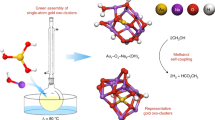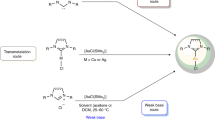Abstract
Low-valent late transition-metal catalysis has become indispensable to chemical synthesis, but homogeneous high-valent transition-metal catalysis is underdeveloped, mainly owing to the reactivity of high-valent transition-metal complexes and the challenges associated with synthesizing them. Here we report a carbon–carbon bond cleavage at ambient conditions by a Au(i) complex that generates a stable Au(iii) cationic complex. In contrast to the well-established soft and carbophilic Au(i) catalyst, this Au(iii) complex exhibits hard, oxophilic Lewis acidity. For example, we observed catalytic activation of α,β-unsaturated aldehydes towards selective conjugate additions as well as activation of an unsaturated aldehyde-allene for a [2 + 2] cycloaddition reaction. The origin of the regioselectivity and catalytic activity was elucidated by X-ray crystallographic analysis of an isolated Au(iii)-activated cinnamaldehyde intermediate. The concepts revealed suggest a strategy for accessing high-valent transition-metal catalysis from readily available precursors.
This is a preview of subscription content, access via your institution
Access options
Subscribe to this journal
Receive 51 print issues and online access
$199.00 per year
only $3.90 per issue
Buy this article
- Purchase on Springer Link
- Instant access to full article PDF
Prices may be subject to local taxes which are calculated during checkout






Similar content being viewed by others
References
Hickman, A. J. & Sanford, M. S. High-valent organometallic copper and palladium in catalysis. Nature 484, 177–185 (2012)
Furuya, T., Kamlet, A. S. & Ritter, T. Catalysis for fluorination and trifluoromethylation. Nature 473, 470–477 (2011)
Lee, E. et al. A fluoride-derived electrophilic late-stage fluorination reagent for PET imaging. Science 334, 639–642 (2011)
Furuya, T. et al. Mechanism of C-F reductive elimination from palladium(IV) fluorides. J. Am. Chem. Soc. 132, 3793–3807 (2010)
Whitfield, S. R. & Sanford, M. S. Reactivity of Pd(II) complexes with electrophilic chlorinating reagents: Isolation of Pd(IV) products and observation of C−Cl bond-forming reductive elimination. J. Am. Chem. Soc. 129, 15142–15143 (2007)
Alsters, P. L. et al. Rigid five- and six-membered C,N,N′-bound aryl-, benzyl-, and alkylorganopalladium complexes: sp2 vs. sp3 carbon-hydrogen activation during cyclopalladation and palladium(IV) intermediates in oxidative addition reactions with dihalogens and alkyl halides. Organometallics 12, 1831–1844 (1993)
Wang, Y.-M., Lackner, A. D. & Toste, F. D. Development of catalysts and ligands for enantioselective gold catalysis. Acc. Chem. Res. 47, 889–901 (2014)
Krause, N. & Winter, C. Gold-catalyzed nucleophilic cyclization of functionalized allenes: a powerful access to carbo- and heterocycles. Chem. Rev. 111, 1994–2009 (2011)
Corma, A., Leyva-Pérez, A. & Sabater, M. J. Gold-catalyzed carbon-heteroatom bond-forming reactions. Chem. Rev. 111, 1657–1712 (2011)
Hamilton, G. L., Kang, E. J., Mba, M. & Toste, F. D. A powerful chiral counterion strategy for asymmetric transition metal catalysis. Science 317, 496–499 (2007)
Gorin, D. J. & Toste, F. D. Relativistic effects in homogeneous gold catalysis. Nature 446, 395–403 (2007)
Schmidbaur, H. & Schier, A. Gold(III) compounds for homogeneous catalysis: preparation, reaction conditions, and scope of application. Arabian J. Sci. Eng. 37, 1187–1225 (2012)
Oliver-Meseguer, J. et al. Small gold clusters formed in solution give reaction turnover numbers of 107 at room temperature. Science 338, 1452–1455 (2012)
Leyva-Pérez, A. & Corma, A. Similarities and differences between the “relativistic” triad gold, platinum, and mercury in catalysis. Angew. Chem. Int. Ed. 51, 614–635 (2012)
Gaillard, S. et al. Synthetic and structural studies of [AuCl3(NHC)] complexes. Organometallics 29, 394–402 (2010)
de Frémont, P., Singh, R., Stevens, E. D., Petersen, J. L. & Nolan, S. P. Synthesis, characterization and reactivity of N-heterocyclic carbene gold(III) complexes. Organometallics 26, 1376–1385 (2007)
Hashmi, A. S. K., Blanco, M. C., Fischer, D. & Bats, J. W. Gold catalysis: evidence for the in situ reduction of gold(III) During the cyclization of allenyl carbinols. Eur. J. Org. Chem. 1387–1389 (2006)
Wolf, W. J., Winston, M. S. & Toste, F. D. Exceptionally fast carbon–carbon bond reductive elimination from gold(III). Nature Chem. 6, 159–164 (2013)
Vicente, J., Bermúdez, M.-D., Carrión, F.-J. & Jones, P. G. Synthesis and reactivity of some nitroaryl complexes of HgII and AuIII — synthesis of a substituted biphenyl by C–C coupling-crystal structure of [Hg(C6H4NO2-3,OnBu-6)2]. Chem. Ber. 129, 1395–1399 (1996)
Roşca, D.-A., Smith, D. A., Hughes, D. L. & Bochmann, M. A thermally stable gold(III) hydride: synthesis, reactivity, and reductive condensation as a route to gold(II) complexes. Angew. Chem. Int. Ed. 51, 10643–10646 (2012)
Hashmi, A. S. K. Fire and ice: a gold(III) monohydride. Angew. Chem. Int. Ed. 51, 12935–12936 (2012)
Usón, R., Vicente, J., Cirac, J. A. & Chicote, M. T. Synthesis and reactivity of dibenzometallole complexes of gold(III) and platinum(II). J. Organomet. Chem. 198, 105–112 (1980)
Pyykkö, P. & Runeberg, N. Comparative theoretical study of N-heterocyclic carbenes and other ligands bound to AuI. Chem. Asian J. 1, 623–628 (2006)
Jones, W. D. Mechanistic studies of transition metal-mediated C–C bond activation. Top. Curr. Chem. 346, 1–31 (2013)
Perthuisot, C. et al. Cleavage of the carbon–carbon bond in biphenylene using transition metals. J. Mol. Catal. Chem. 189, 157–168 (2002)
Darmon, J. M. et al. Oxidative addition of carbon–carbon bonds with a redox-active bis(imino)pyridine iron complex. J. Am. Chem. Soc. 134, 17125–17137 (2012)
Levin, L. D. & Toste, F. D. Gold-catalyzed allylation of aryl boronic acids: accessing cross-coupling reactivity with gold. Angew. Chem. Int. Ed. 53, 6211–6215 (2014)
Fackler, J. P., Jr Metal-metal bond formation in the oxidative addition to dinuclear gold(I) species. Implications from dinuclear and trinuclear gold chemistry for the oxidative addition process generally. Polyhedron 16, 1–17 (1997)
Guenther, J. et al. Activation of aryl halides at gold(I): practical synthesis of (P,C) cyclometalated gold(III) complexes. J. Am. Chem. Soc. 136, 1778–1781 (2014)
Joost, M. et al. Facile oxidative addition of aryl iodides to gold(I) by ligand design: bending turns on reactivity. J. Am. Chem. Soc. 136, 14654–14657 (2014)
Weber, S. G., Rominger, F. & Straub, B. F. Isolated silver intermediate of gold precatalyst activation. Eur. J. Inorg. Chem. 2863–2867 (2012)
North, M., Usanov, D. L. & Young, C. Lewis acid catalyzed asymmetric cyanohydrin synthesis. Chem. Rev. 108, 5146–5226 (2008)
Yamamoto, H. (ed.) Lewis Acids in Organic Synthesis 1–995 (Wiley, 2000)
Mahrwald, R. Diastereoselection in Lewis-acid-mediated aldol reactions. Chem. Rev. 99, 1095–1120 (1999)
Maruoka, K., Imoto, H., Saito, S. & Yamamoto, H. Virtually complete blocking of α,β-unsaturated aldehyde carbonyls by complexation with aluminum tris(2,6-diphenylphenoxide). J. Am. Chem. Soc. 116, 4131–4132 (1994)
Hadfield, M. S. & Lee, A.-L. Gold(I)-catalyzed synthesis of conjugated trienes. Chem. Commun. 47, 1333–1335 (2011)
Akagawa, K., Nishi, N., Sen, J. & Kudo, K. Peptide-catalyzed consecutive 1,6- and 1,4-additions of thiols to α,β,γ,δ-unsaturated aldehydes. Org. Biomol. Chem. 12, 3581–3585 (2014)
Akagawa, K., Sen, J. & Kudo, K. Peptide-catalyzed regio- and enantioselective reduction of α,β,γ,δ-diunsaturated aldehydes. Angew. Chem. Int. Ed. 52, 11585–11588 (2013)
Ahrendt, K. A., Borths, C. J. & MacMillan, D. W. C. New strategies for organic synthesis: the first highly enantioselective organocatalytic Diels-Alder reaction. J. Am. Chem. Soc. 122, 4243–4244 (2000)
Hayashi, Y., Okamura, D., Umemiya, S. & Uchimaru, T. Organocatalytic 1,4-addition reaction of α,β,γ,δ-diunsaturated aldehydes versus 1,6-addition reaction. ChemCatChem 4, 959–962 (2012)
Alcaide, B., Almendros, P. & Arancillo, C. Exploiting [2 + 2] cycloaddition chemistry: achievements with allenes. Chem. Soc. Rev. 39, 783–816 (2010)
Hashmi, A. S. K. et al. On homogeneous gold/palladium catalytic systems. Adv. Synth. Catal. 354, 133–147 (2012)
Livendahl, M., Goehry, C., Maseras, F. & Echavarren, A. M. Rationale for the sluggish oxidative addition of aryl halides to Au(I). Chem. Commun. 50, 1533–1536 (2014)
Hashmi, A. S. K., Frost, T. M. & Bats, J. W. Highly selective gold-catalyzed arene synthesis. J. Am. Chem. Soc. 122, 11553–11554 (2000)
Acknowledgements
We gratefully acknowledge the NIHGMS (RO1 GM073932) for financial support. C.-Y.W. thanks the Taiwan National Science Council for a postdoctoral fellowship (2011-2012). T.H. thanks the Uehara Memorial Foundation for a postdoctoral fellowship. C.B.J. is grateful to the Lundbeck Foundation for a postdoctoral fellowship. We thank A. DiPasquale (at the College of Chemistry X-ray Crystallography Facility of the University of California, Berkeley) for X-ray crystallographic data collection and we acknowledge support from the NIH Shared Instrumentation Grant S10-RR027172. We thank H.-J. Liu for his generous donation of the biphenylene.
Author information
Authors and Affiliations
Contributions
C.-Y.W. initiated and developed the organometallic study. C.-Y.W. and T.H. developed the Lewis-acid catalysis. C.-Y.W., T.H. and C.B.J. optimized the Lewis-acid catalysis study. C.-Y.W., T.H. and C.B.J. performed the experiments. C.-Y.W., T.H. and C.B.J. and F.D.T. wrote the manuscript.
Corresponding author
Ethics declarations
Competing interests
The authors declare no competing financial interests.
Additional information
X-ray crystallographic data have been deposited in the Cambridge Crystallographic Data Centre database (http://www.ccdc.cam.ac.uk/) under code CCDC 1002525-1002527.
Supplementary information
Supplementary Information
This file contains Supplementary Text and Data, Supplementary Figures 1-5, Supplementary Tables 1-20 and Supplementary References. (PDF 23602 kb)
Rights and permissions
About this article
Cite this article
Wu, CY., Horibe, T., Jacobsen, C. et al. Stable gold(III) catalysts by oxidative addition of a carbon–carbon bond. Nature 517, 449–454 (2015). https://doi.org/10.1038/nature14104
Received:
Accepted:
Published:
Issue Date:
DOI: https://doi.org/10.1038/nature14104
This article is cited by
-
Exploitation of cost-effective renewable heterogeneous base catalyst from banana (Musa paradisiaca) peel for effective methyl ester production from soybean oil
Applied Nanoscience (2023)
-
Foundations and strategies of the construction of hybrid catalysts for optimized performances
Nature Catalysis (2018)
-
Rational development of catalytic Au(I)/Au(III) arylation involving mild oxidative addition of aryl halides
Nature Communications (2017)
-
The merger of transition metal and photocatalysis
Nature Reviews Chemistry (2017)
-
Gold unleashes the power of three
Nature (2015)
Comments
By submitting a comment you agree to abide by our Terms and Community Guidelines. If you find something abusive or that does not comply with our terms or guidelines please flag it as inappropriate.



